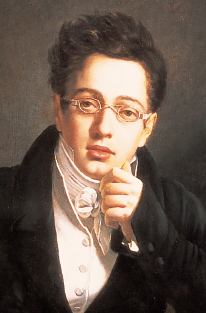Biography
Franz Schubert (1797–1828)

Schubert was the son of a lower-
Schubert was an endearing but shy and unspectacular individual who led an unspectacular life. However, it was the sort of life that would have been impossible before the Romantic era. Schubert never married — it is believed he was gay — and never held a regular job. He was sustained by odd fees for teaching and publications and by contributions from a circle of friends who called themselves the Schubertians — young musicians, artists, writers, and music lovers. One of the Schubertians, Moritz von Schwind, who became an important painter, has left us many charming pictures of the group at parties, on trips to the country, and so on (see page 235).
It was an atmosphere especially conducive to an intimate musical genre such as the lied. Schubert wrote nearly seven hundred lieder and many choral songs. For a time he roomed with a poet, Johann Mayrhofer, who provided him with gloomy texts for about fifty of them.
But it’s unfortunate that Schubert’s wonderful songs have tended to overshadow his symphonies, sonatas, and chamber music. Starting out with Classical genres, Schubert in his very short lifetime transformed them under the influence of Romanticism. He never introduced himself to Beethoven, even though they lived in the same city; perhaps he instinctively felt he needed to keep his distance from the overpowering older master. It speaks much for Schubert that he was able to write such original and powerful works as the “Unfinished” Symphony, the so-
A few of Schubert’s instrumental works include melodies taken from his own songs: the popular Trout Quintet, the String Quartet in D Minor (Death and the Maiden), and the Wanderer Fantasy for piano.
Schubert died in a typhoid fever epidemic when he was only thirty-
Our portrait shows Schubert around the time he wrote The Erlking.
Chief Works: Lieder, including the song cycles Die schöne Müllerin, Winterreise, and Schwanengesang, “The Erlking,” “Gretchen at the Spinning Wheel,” “Hedgerose,” “Death and the Maiden,” “The Trout,” and hundreds of others ◼ “Character” pieces for piano; waltzes ◼ Symphonies, including the “Unfinished” — Schubert completed only two movements and sketches for a scherzo — and the Great Symphony in C ◼ Piano sonatas; Wanderer Fantasy for piano ◼ Four mature string quartets; a string quintet; the genial Trout Quintet for piano and strings (including double bass)
Encore: After “The Erlking,” listen to the “Unfinished” Symphony and songs from Winterreise.
Image credit:Kunsthistorisches Museum, Vienna, Austria/The Bridgeman Art Library.